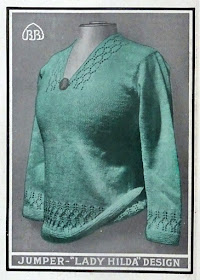In 1920, the two companies merged to form Patons & Baldwins, of Alloa and Halifax. But for several years afterwards, the component companies seem to have operated separately to some degree, placing separate ads for their products, sometimes in the same magazine, and they carried on publishing both Beehive Booklets and Helps to Knitters.
Also in the early 20s, Baldwins started to produce a series of "Beehive Recipe Cards".
 |
| Beehive Card No. 34 |
While the booklets were at least four pages long, and often more, recipe cards were suitable for simpler patterns that would fit onto both sides of a single sheet of card, with a small photo.
There are only three of the cards in the Knitting & Crochet Guild collection: one has patterns for two crocheted hats, a sailor hat and a tam o' shanter. The others are dress patterns for little girls: the 'Nancy' design has a simple dress with knickers (a rather loose pair of knitted shorts), while the 'Isobel' design is a fancier dress, modelled by a glum-looking child wearing an enormous bow in her hair.
 |
| Beehive Card No. 54 |
The cards were advertised alongside the Beehive booklets for a few years, using a drawing based on the photo on the card. Presumably that was cheaper than reproducing the photo, but sometimes the drawing is more attractive than the photo, to my mind.
 |
| Beehive Card No. 71, advertised in 1924. |
 |
| Photo from Beehive Card No. 71 (from the copy in the British Library) |
The British Library has 86 of the recipe cards, which seems to be a complete set. They all have a British Museum stamp with dates between December 1921 and July 1924. (The British Library used to be housed in the British Museum.) So evidently the cards were short-lived - perhaps the company decided that it was too complicated to keep publishing patterns in two different formats. A recipe card could easily be expanded to a 4-page booklet - have a bigger photo to fill the first page, add a few washing hints perhaps, and if necessary use the last page to show illustrations of some of the other booklets available. Though from the knitter's point of view, it seems to me that a single sheet of card is more convenient than a flimsier 4-page booklet.
Here are a couple more photos from the cards, to show that they weren't all underwear or children's patterns.
 |
| Photo from Beehive Card No. 22 (from the copy in the British Library) |
Card No. 22 has room for a description of the garment:
The "Lady Hilda" Blouse Jumper is very light in weight and makes a dainty garment for wearing under a Coat or indoors. The lacey pattern introduced into the neck, cuffs and border, nicely worked, makes the garment a very stylish one.Later cards dropped the description, and the tinting of the photo, and used real models rather than dress stands.
 |
| Photo from Beehive Card No. 84 (from the copy in the British Library) |
The Rachael design from Card No. 84 is a crocheted jumper, in Kingfisher Lustre Wool, a wool-rayon mix. The front and back are identical T shapes, typical of early 20s jumpers - as is the cord belt with tassel.
The set of recipe cards give a comprehensive picture of what knitters and crocheters were being encouraged to make in the early 1920s. Possibly many of the cards only survive now in the British Library - it is a wonderful institution.
Ummm - as a beekeeper, what is a "Beehive Card"?
ReplyDeleteSorry, that post was very obscure to non-knitters. The Beehive was Baldwins' trademark, so they called their publications Beehive Booklets, Beehive cards, etc. It continued to be the trademark of Patons & Baldwins after the two companies merged, and is still their trademark, even though 'Baldwins' has been dropped from the company name. The nicest thing that uses the beehive trademark is the beehive shaped yarn holder - they were very popular when they were first produced, and secondhand ones are much in demand - you can see a selection on a post I wrote a few years ago: https://barbaraknitsagain.blogspot.com/2014/06/yarn-holders.html
DeleteThough possibly that is not a shape of beehive that modern beekeepers use?
Barbara I'm wondering if you know why the Beehive was chosen as the Baldwins' trademark?
ReplyDeleteI'm sorry, I don't. I imagine that it was intended as a symbol of industriousness, but if there was some specific reason for choosing it, I don't know what it was.
Delete